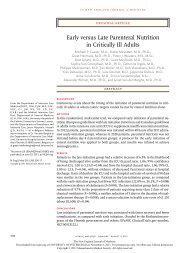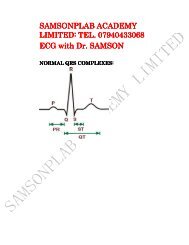ACLS Review
You also want an ePaper? Increase the reach of your titles
YUMPU automatically turns print PDFs into web optimized ePapers that Google loves.
26 <strong>ACLS</strong> (Advanced Cardiac Life Support) <strong>Review</strong> ...<br />
❍<br />
❍<br />
What is the most common cause of an accelerated junctional rhythm?<br />
Digitalis toxicity<br />
What is the following rhythm?<br />
Atrial fibrillation with runs of ventricular tachycardia.<br />
❍<br />
❍<br />
What are the ECG findings suspected in a patient with hyperkalemia?<br />
K 6.5–7.5 mEq/L: Prolonged P–R interval, widened QRS, decrease in P wave amplitude, tall-peaked T waves, and<br />
ST segment depressed or elevated.<br />
K 7.5–8.5 mEq/L: Wide QRS, further flattening of the P wave with widening, and bundle branch blocks as well as<br />
AV blocks may occur.<br />
K greater than 8.5 mEq/L: P wave is absent, very wide QRS, ventricular dysrhythmias including V-fib, V-tach, and<br />
asystole.<br />
What are the causes of cardiac dysrhythmias?<br />
Disturbances in conductivity, such as with Wolff–Parkinson–White syndrome, or AV block and disturbances in<br />
automaticity, such as premature atrial, junctional or ventricular complexes, atrial or ventricular tachycardia, sinus<br />
bradycardia, and sinus tachycardia.<br />
❍ A conduction defect above the level of the His bundle will result in .<br />
Changes in P wave and P–R interval.<br />
❍ Conduction defects at or below the level of the His bundle will result in .<br />
Conduction problems involving the QRS complex with QRS widening.<br />
❍<br />
❍<br />
What is supraventricular tachycardia (SVT)?<br />
It is a nonspecific dysrhythmia that cannot be individually distinguished due to its high rate. SVT is characterized<br />
by a narrow QRS complex in which P waves often cannot be distinguished from the preceding T wave.<br />
What are the possible causes of torsades de pointes?<br />
Anorexia, bulimia, electrolyte abnormalities, and drug-induced; typically by tricyclic antidepressants. Also,<br />
antidysrhythmics, including procainamide, flecainide, and quinidine, antibiotics, such as erythromycin, and<br />
antihistamines, such as terfenadine.







